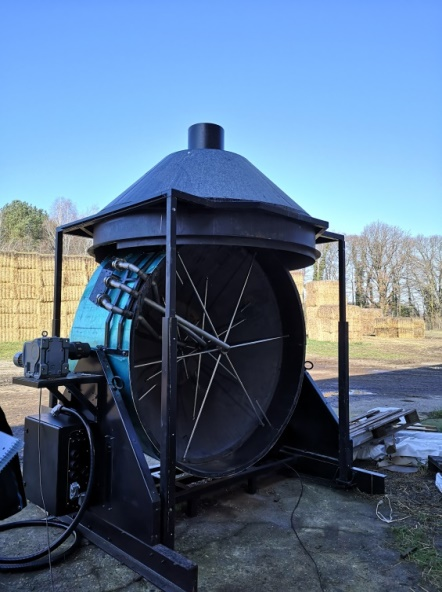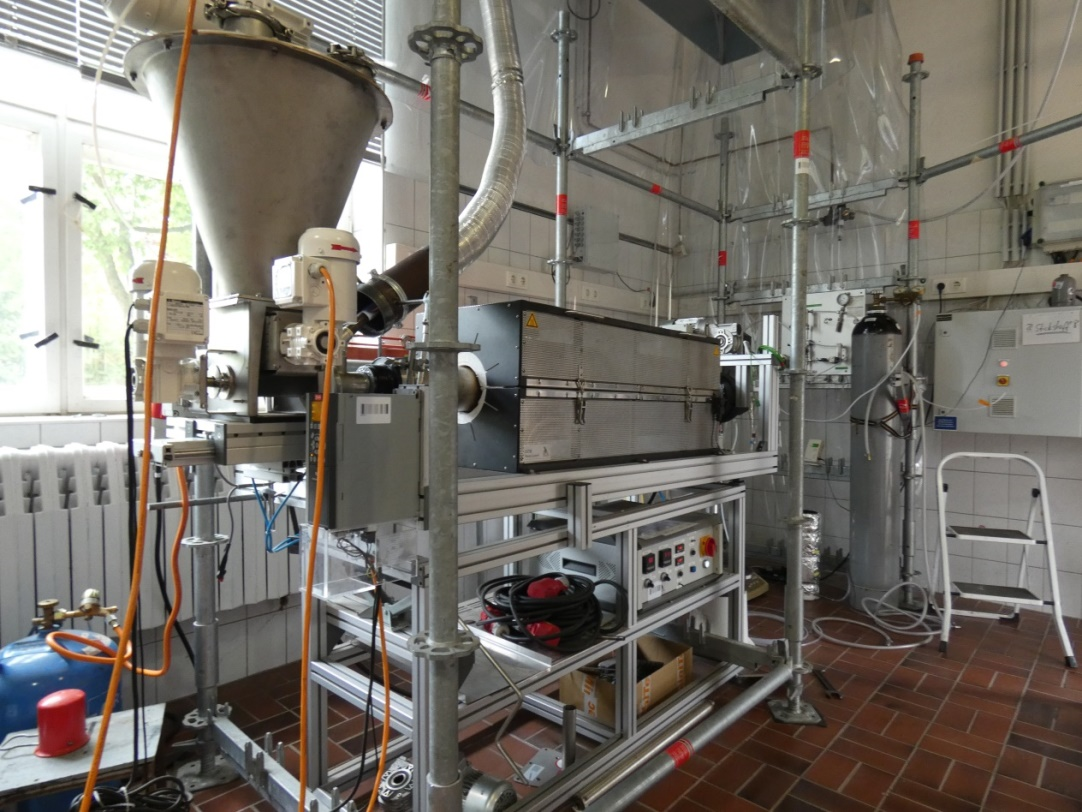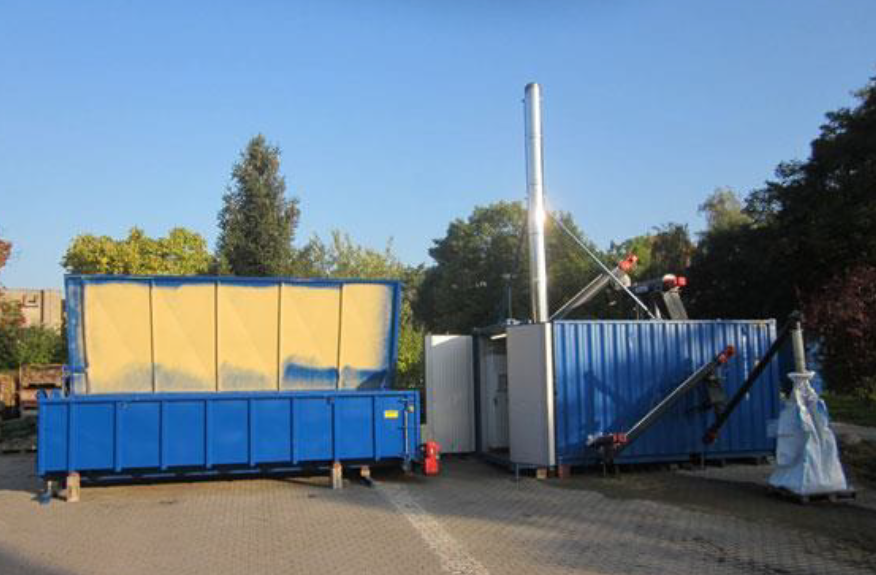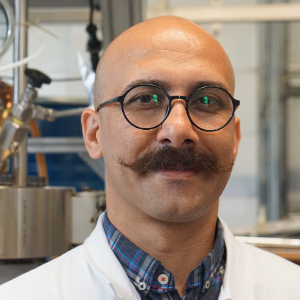WG Thermochemical conversion
The objective of thermochemical conversion group activity is to explore and optimize the hydrothermal carbonization (HTC), hydrothermal humification (HTH), and pyrolysis processes for the production of hydrochar, humic substances, and pyrochar. The focus will be on the application of these materials for soil amendment, including increasing water retention, cation and anion exchange capacity, and long-term carbon storage. Additionally, the group will investigate the adsorption of nutrients and pollutants from water, soil, and animal manure, as well as the purification of carbonous materials for advanced applications such as membrane and energy storage. The modeling and optimization help to scale up the processes and transition from batch to continuous processes.




Hydrothermal Carbonization (HTC) and Humification (HTH)
HTC is conducted at elevated temperatures typically ranging from 180 to 250 degrees Celsius, represents an environmentally friendly technology for converting wet residues into hydrochar. Hydrochar finds applications in soil improvement, environmental remediation, biofuel production, and energy storage.
HTH accelerates the production of humic compounds from biomass—a complex process that typically takes years in nature—and accomplishes it within a few hours, delivering significant advantages for soil enhancement. The products are primarily used in agriculture, soil enhancement, and various environmental applications.
Batch and Continuous Hydrothermal Reactors
Available hydrothermal equipment includes high pressure batch reactors (150 mL, 1 L, 18.75 L) as well as a continuous reactor from Artec. Further details on post-processing steps can be found in Biochar laboratory.

Pyrolysis Process
Pyrolysis is a thermal decomposition process that takes place in the absence of oxygen. It entails exposing carbon-rich materials, such as biomass or organic waste, to elevated temperatures, typically ranging from 300 to 800 degrees Celsius. One of the key outcomes of pyrolysis is the conversion of dry carbonaceous materials into stable forms of carbon known as pyrochar. This pyrochar has a wide range of applications, including its use in soil improvement, biofuel production, and various environmental applications. Furthermore, pyrochar can be engineered or activated to enhance its properties, making it suitable for catalysis, adsorption processes, and energy storage.




Pyrolysis Reactors
Pyrolysis (batch and contnious)
Available pyrolysis equipment includes batch pyrolysis muffle furnaces and continuous reactors, including a rotary kiln, a carbon twister, as well as a pyrolysis unit from BIOMACON. Further details on post-processing steps of pyrochar can be found in Biochar laboratory.

Group activities:
1- Process understanding and scale up (Modeling and optimization)
Development of empirical and thermo-chemical models that enable a deeper understanding of complex reactions is a crucial step to scale up the thermochemical conversion processes. This progress extends to kinetic modeling, particularly in the fields of hydrothermal carbonization (HTC) and hydrothermal humification (HTH), where predictive models are enhancing our ability to optimize these processes. Moreover, the integration of intelligent modeling techniques is transforming process optimization, allowing for more efficient and sustainable production methods. These models, helps to predict the system and transitions from traditional batch processes to continuous operations, promising increased efficiency, reduced waste.
- Development of empirical and thermo-chemical models.
- Kinetic modeling of HTC and HTH.
- Intelligent modeling for process optimization.
- Transitioning from batch to continuous processes.
Smart integrated biorefineries
2- Production of engineered pyrochar and hydrochar and artificial humic substances for different applications
a) Soil Amendment and Carbon Storage:
- Investigating the interaction of carbon-rich substances with soil and plants.
- Developing porous pyrochar particles for soil improvement.
- Producing engineered pyrochar with high carbon sequestration efficiency.
- Evaluating the potential for carbon-rich materials to act as carbon sinks.
b) Nutrient recovery and pollutant removal:
- Surface modification and functionalization of hydrochar and pyrochar.
- Engineering of pyrochar and hydrochar for selective nutrient and pollutant adsorption.
- Studying adsorption capacity for nutrients and pollutants in water, soil, and manure.
- Exploring applications for water and soil remediation.
c) Purification of carbonous materials and advanced applications:
- Purification and doping of carbonous materials for advanced applications like membrane technology and catalysis.
- Developing customized char particles for specific applications.
- Regeneration and reuse of spent carbon-based materials.
- Removal of pollutants, including PAHs and inorganic elements, from carbonous materials.
- Synthesis of carbon based catalysts
- Alternative catalysts for hydrothermal humifcation
Catalytic application of biochar and hydrochar energy productioon
3- Integrated residue management:
Under integrated residue management program area, the group aims to use the organic waste and residues produced in other processes, and convert it to a more stable form of carbon. The resulted products, based on their characteristics, can be recycled back to the process they are originated from, to increase the yield, and or purification of the products. The products can be applied to other purposes, such as biofuel production, soil and environmental applications.
4- Collaboration with industry
Our group's activities extend beyond research as we actively engage in close collaboration with our industrial partners. We are dedicated to addressing their specific needs, offering support in areas such as process development, product characterization, process optimization, and scaling up. This collaborative approach ensures that our research not only advances scientific knowledge but also directly contributes to real-world applications and the success of our industry partners.
5- Characterization and analysis of thermochemical conversion products:
- Elemental analysis, ICP-OES, and nutrient content (P and N)
- Analysis of gaseous products of pyrolysis and HTC processes
- HPLC for organic acids, aromatics, and sugars in solid and liquid products
- Extraction and analysis of humic compounds
- Characterization through FTIR, BET surface area, pore size analysis, TGA, SEM-EDX
- Recalcitrance and soil carbon sequestration potential of biomass, hydrochar, artificial humic substances and biochar
- Water absorbing capacity of biomass, hydrochar, aritificial humic substances and biochar
Recent group publications:
Marzban, N.; Psarianos, M.; Herrmann, C.; Schulz-Nielsen, L.; Olszewska-Widdrat, A.; Arefi, A.; Pecenka, R.; Grundmann, P.; Schlüter, O.; Hoffmann, T.; Rotter, V.; Nikoloski, Z.; Sturm, B. (2025): Smart integrated biorefineries in bioeconomy: A concept toward zero-waste, emission reduction, and self-sufficient energy production. Biofuel Research Journal. (1): p. 2319-2349. Online: https://doi.org/10.18331/BRJ2025.12.1.4
Mohammadi, P.; Dang, H.; Román, S.; Duman, G.; Akdeniz, R.; Kömekçi, F.; Nik Ghazali, N.; De Tender, C.; Kulli, B. (2025): Can biomass-derived chars serve as a viable alternative to commercial inorganic fertilizers?. Biofuel Research Journal. (1): p. 2350-2372. Online: https://doi.org/10.18331/BRJ2025.12.1.5
Höfle, D.; Sperber, S.; Marzban, N.; Antonietti, M.; Hoffmann, T.; Wicaksono, W.; Abdelfattah, A.; Berg, G. (2024): Artificial Humic Acid Diminishes the Effect of Drought on the Soil Microbiome. Journal of sustainable agriculture and environment. (4 (October 2024)): p. 1-11. Online: https://doi.org/10.1002/sae2.70034
Maleki, A.; Amini, N.; Rezaee, R.; Safari, M.; Marzban, N.; seifi, M. (2024): Fabrication of Cu@Ag core-shell/Nafion/polyalizarin: applications to simultaneous electrocatalytic oxidation and reduction of nitrite in water samples. Heliyon. (1): p. 40979. Online: https://doi.org/10.1016/j.heliyon.2024.e40979
Mohammadi, S.; Pashaee, A.; Amini, N.; Marzban, N.; Puttaiah, S.; Tang, V.; Maleki, A. (2024): Green carbon dots derived from honey, garlic, and carrot: Synthesis, characterization, and antibacterial properties. Biomass Conversion and Biorefinery. : p. 1-15. Online: https://doi.org/10.1007/s13399-024-06349-9
Santolin, C.; Hübner, K.; Schneider, R.; Alves, H.; Marzban, N.; Scheufele, F. (2024): Eco-friendly micro-mesoporous carbon from sucrose and sodium metasilicate template for ciprofloxacin adsorption: Effect of molecules self-association over diffusion mechanisms. Chemical Engineering Science. (5 February 2025): p. 120907. Online: https://doi.org/10.1016/j.ces.2024.120907
Sarlaki, E.; Kianmehr, M.; Marzban, N.; Shafizadeh, A.; Tajuddin, S.; Hu, S.; Tabatabaei, M.; Aghbashlo, M. (2024): Advances and challenges in humic acid production technologies from natural carbonaceous material wastes. Chemical Engineering Journal. (15 October 2024): p. 155521. Online: https://doi.org/10.1016/j.cej.2024.155521
Kohzadi, S.; Bundschuh, M.; Rezaee, R.; Marzban, N.; Vahabzadeh, Z.; Ali Johari, S.; Shahmoradi, B.; Amini, N.; Maleki, A. (2024): Integrating machine learning with experimental investigation for optimizing photocatalytic degradation of Rhodamine B using neodymium-doped titanium dioxide: a comprehensive approach with toxicity assessment. Environmental Science and Pollution Research. : p. 55301-55316. Online: https://doi.org/10.1007/s11356-024-34843-0
Jeon, H.; Kim, D.; Scheufele, F.; Ro, K.; Libra, J.; Marzban, N.; Chen, H.; Ribeiro, C.; Jeong, C. (2024): Occurrence of Polycyclic Aromatic Hydrocarbons (PAHs) in Pyrochar and Hydrochar during Thermal and Hydrothermal Processes. Agronomy. (9): p. 2040. Online: https://doi.org/10.3390/agronomy14092040
Moloeznik Paniagua, D.; Krenz, L.; Libra, J.; Korf, N.; Rotter, V. (2024): Towards a high-quality fertilizer based on algae residues treated via hydrothermal carbonization. Trends on how process parameters infuence inorganics. Biochar. : p. 67. Online: https://doi.org/10.1007/s42773-024-00357-8
News:
1- We are delighted to announce that Dr. Nader Marzban, nominated by ATB and the Leibniz Association, has been selected to attend the 74th Lindau Nobel Laureate Meeting in Chemistry. In recognition of his outstanding work in green chemistry and artificial humic substances, Dr. Marzban will represent Germany and the Leibniz Association at this prestigious, once-in-a-lifetime event, joining Nobel Laureates and top young scientists from around the world. We warmly congratulate him on this exceptional achievement!
2- In May 2025, Chau Dang defended his doctoral thesis titled "Valorization of By-products from Wet Coffee Processing: Waste to Carbon-rich Material Using Hydrothermal Carbonization to Improve the Sustainability of the Coffee Value Chain in Vietnam" at the Institute for Waste and Circular Economy, TU Dresden, under the guidance of Prof. Dr. Christina Dornack.We congratulate Chau on this very good result and wish her all the best for her scientific career. A special thanks goes to Dr. habil. Judy Libra, who generously supervised Chau's work despite having been retired for nearly three years. Dear Judy, thank you very much for your dedication and continued commitment!.
3- ATB researchers, have published a groundbreaking concept paper in Biofuel Research Journal outlining a vision for smart integrated biorefineries. The concept combines thermochemical and biological processes—such as pyrolysis, fermentation, and hydrothermal humification—into a zero-waste, energy self-sufficient system. The paper showcases how combining advanced technologies like AI, digital twins, and real-time sensing can enable highly flexible and sustainable biomass conversion pathways using regional and seasonal residues Construction of a new demonstration biorefinery in Groß Kreutz will begin this March, as part of ATB’s efforts to translate this concept into practice. The work is supported by partners from the University of Potsdam and TU Berlin, and aligns with the vision of the Leibniz Innovation Farm for Sustainable Bioeconomy (InnoHof®). Read the full article here: DOI: 10.18331/BRJ2025.12.1.4
Also press relase here: https://renewable-carbon.eu/news/mehrwert-ohne-abfall-atb-forscher-konzipieren-neuartige-bioraffinerie-2/
4- We are thrilled to announce that Dr. Nader Marzban has been selected to attend the 74th Lindau Nobel Laureate Meeting on Chemistry, taking place from 29 June to 4 July 2025 in Lindau. Nominated by ATB and the Leibniz Association, he will present his research on artificial humic substances and engage with Nobel Laureates and fellow scientists in discussions on sustainable chemistry and bioeconomy. Congratulations, Nader!
5-Our group does pioneering work: Artificially produced humic substances for agriculture
https://www.atb-potsdam.de/en/news-and-press/news/news-details/artificially-produced-humic-substances-for-agriculture
https://www.tagesspiegel.de/wissen/flussiger-humus-potsdamer-erkochen-sich-fruchtbarkeit-von-boden-12955723.html
6- After the HTC Symposiums in London (2017), Berlin (2019), and Seoul (2023), ATB is once again a co-organizer for the upcoming 4th International Symposium on Hydrothermal Carbonization, which will be held from January 28-31, 2025, in New Orleans, Louisiana, USA.
The symposium will focus on the following areas:
Fundamentals of hydrothermal carbonization, Feedstock selection and characterization, Process optimization and reactor design, Product characterization and applications, Environmental impacts and sustainability assessments, Economic viability and market perspectives, Integration with other processes (e.g., wastewater treatment, biorefinery, More information can be found at the 2025 HTC Meeting website: htc2025neworleans.netlify.app.
7- Dr. Opeyemi Ayodeji Akogun has joined the Thermochemical Conversion group as a Postdoctoral Researcher, funded by the Alexander von Humboldt Foundation, for two years. He will be working on the pyrolysis and hydrothermal conversion of biomass for soil and fuel applications.
8- On December 21, 2023, Nader Marzban successfully defended his thesis titled "From Hydrothermal Carbonization to Hydrothermal Humification of Biomass: The Role of Process Conditions," earning the highest distinction, Summa Cum Laude, from the Faculty of Process Engineering at Technische Universität Berlin. Starting January 1st, he will begin his new role as a Scientific Group Leader at ATB (Under mentorship of Dr. Thomas Hoffmann), working with the Thermochemical Conversion group. We wish him continued success in his future endeavors.
Mitarbeiter*innen der AG
Postdocs:
Opeyemi Ayodejl Akogun
Huyen Chau Dang
PhD students:
Daniela Moloeznik Paniagua
Saman Ghobadian
Mohaddesseh Ebrahimi
Master students:
Jonas Alexis Buchholz
Wei-Che Hsiao
Niloufar Hamzehlou
Guest Scientists:
Prof. Dr. Fabiano Bisinella Scheufele
Prof. Dr. Caroline Ribeiro
Technicians
Dipl.-Ing. (FH) Marcus Fischer
Imke Handke




